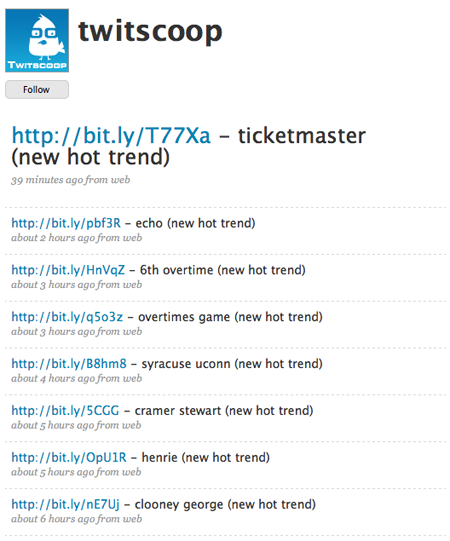Yesterday, I put the finishing touches on my first book, an O’Reilly Media tome about the Twitter API. I’ll write more about that next week, when the book is released. One of the third-party applications I profiled in Chapter 2 is a personal favorite, Twitscoop.
UPDATE: Want proof the Internet works? Lollicode responded to this blog (see comments) and addressed these issues less than two hours after I posted this at 4:50a. Awesome. Follow @twitscooptrends for trending alerts.
Lollicode’s Twitscoop (http://www.twitscoop.com) is arguably the best tool for showing what is trending on Twitter. It leverages the mathematics of financial markets to crawl hundreds of new tweets every minute, extracting the most interesting new words people are posting. The results are displayed in a dynamic tag cloud that moves as the terms change in popularity (There are some widgets to integrate the dynamic cloud into websites). Twitscoop also keeps tabs on its own list of trending topics … different from the one Twitter shares through its search API.
For example, Twitter is currently showing the top trending items as Jim Cramer, #sxsw, Diddy, Daily Show, Austin, John Stewart, Watchmen, Syracuse, Red Nose Day, and Goodnight. Twitscoop’s list: ticketmaster, echo, overtime syracuse 6th, game overtimes, 4th, triple, stewart cramer, henrie, george clooney, and edenfantasys. The differences reveal a greater sense of now in the collective answer to Twitter’s prompt question, “What are you doing?”
On page 66 of the book, I note:
What makes Twitscoop so influential and useful, however, is not simply the fancy web work and computation. Twitscoop has its own Twitter account, which it uses to broadcast the more interesting changes in public chatter as they are detected. I’ve found that I am much more likely to go and explore the site when I’m first prompted that something interesting is going on there. Now, whenever I want to check whether some repetition in my personal information stream has become widespread, I visit Twitscoop to look for the terms in its cloud.
Something interesting and a little disturbing happened to that @twitscoop account recently. On March 10, presumably as part of the current redesign of the site, Lollicode appears to have injected automation into their information stream. Instead of this:
followers now get this:
Not only does this reek of the impersonal, it also feels noisy. I believe there are people who will find the immediacy of the trends changes to be constructive and desired, but I’m not one of them.
Before the 10th, I felt connected to whatever human was manning the account, as if that person were taking some active role in the filtering of what was interesting. I clicked on the links provided, all pointing back to Twitscoop, on a regular basis. I don’t do that with the “new hot trend” tweets.
There are two suggestions I can make to remedy the impersonal nature of new use for the Twitscoop account:
- Create separate accounts—Digg (or an evangelist of Digg) has several accounts tied to different areas and levels of interest. I follow @digg_2000, which only posts when an item reaches the magic plateau of 2000 diggs. While some of this information is “old” news by the time it is posted here as a tweet, most of it is unique to that community and adds value to my Twitter stream. Similarly, someone tied Twitter to a Dow Jones stock market feed that reports when the index rises or falls by 50, 100 or 200 points. Twitscoop could easily create some special trending accounts with similar throttles. I would probably subscribe to one that groups the trend changes in fives.
- Add context to the automation—Currently, Twitscoop is posting their new trends tweets in a form of: “http://bit.ly/pbf3R – trending term (new hot trend).” Boring. Unhelpful. With all of the great use of algorithms by Lollicode, it doesn’t seem like a stretch to turn this into a form of a retweet, taking a sample human-written tweet and using it as the alert. As in, “♺ @msrez: thinks the Ticketmaster web site sucks, and just wants a fair way of purchasing an MJ ticket. — http://bit.ly/pbf3R.” Certainly, there would have to be some intelligence added to the automated selection, perhaps in the form of trending terms within the subset of tweets about the main trend. However, I would be much more interested to read some context to the trend rather than just get a single word or phrase as a prompt.
Either way, the current form of automated posting would stop on the @twitscoop account.
There is some irony to this article, of course, since a number of people will be notified of its existence by an automated tweet in my own Twitter stream using Twitterfeed. I’m clearly not against automation as a rule. One definite benefit to the current approach is research; it would very easy to track changes in trends at a granular level simply by mining the @twitscoop tweet stream. I would love to see that information provided in a different delivery format, however, and return @twitscoop to the humans.

